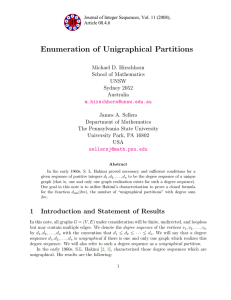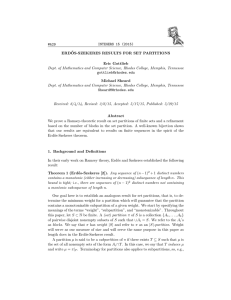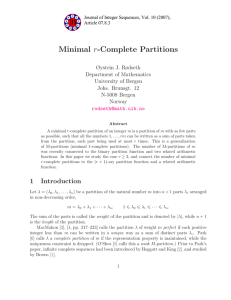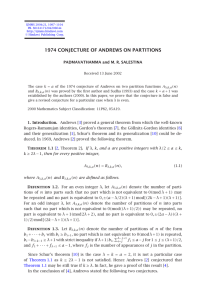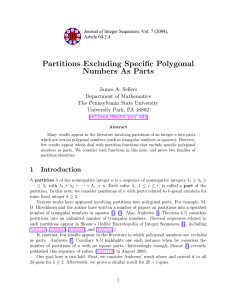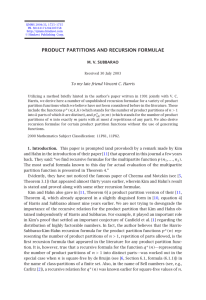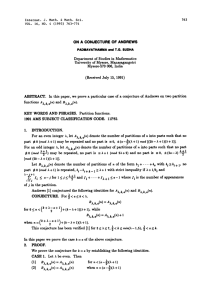Integer Partitions and Convexity
advertisement
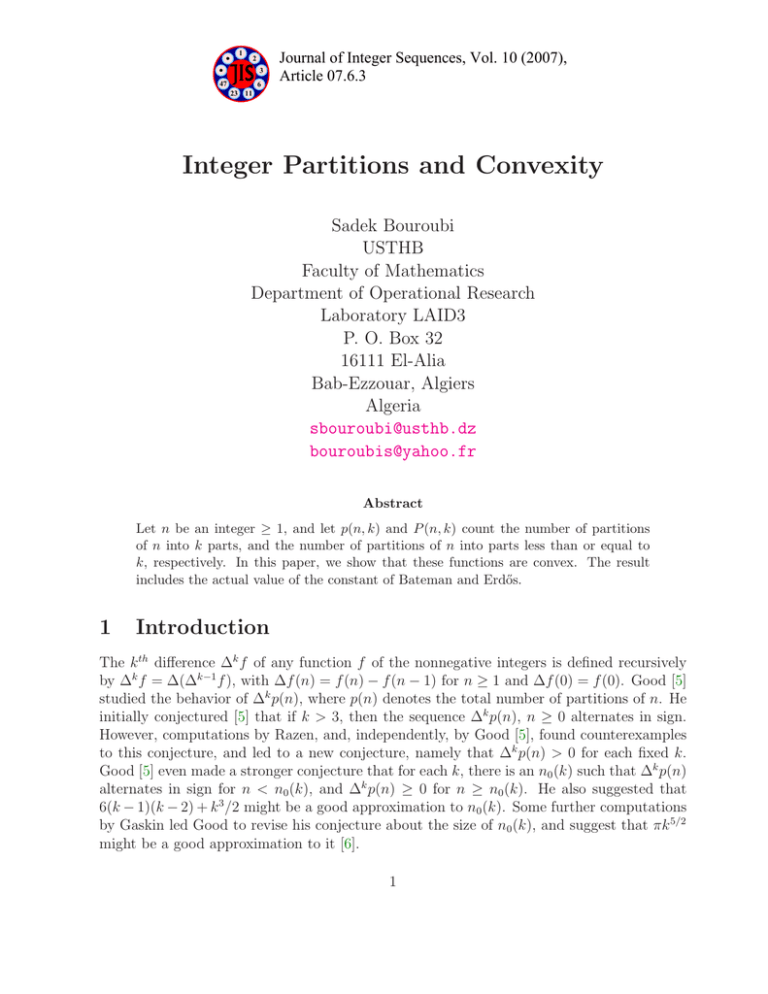
1
2
3
47
6
Journal of Integer Sequences, Vol. 10 (2007),
Article 07.6.3
23 11
Integer Partitions and Convexity
Sadek Bouroubi
USTHB
Faculty of Mathematics
Department of Operational Research
Laboratory LAID3
P. O. Box 32
16111 El-Alia
Bab-Ezzouar, Algiers
Algeria
sbouroubi@usthb.dz
bouroubis@yahoo.fr
Abstract
Let n be an integer ≥ 1, and let p(n, k) and P (n, k) count the number of partitions
of n into k parts, and the number of partitions of n into parts less than or equal to
k, respectively. In this paper, we show that these functions are convex. The result
includes the actual value of the constant of Bateman and Erdős.
1
Introduction
The k th difference ∆k f of any function f of the nonnegative integers is defined recursively
by ∆k f = ∆(∆k−1 f ), with ∆f (n) = f (n) − f (n − 1) for n ≥ 1 and ∆f (0) = f (0). Good [5]
studied the behavior of ∆k p(n), where p(n) denotes the total number of partitions of n. He
initially conjectured [5] that if k > 3, then the sequence ∆k p(n), n ≥ 0 alternates in sign.
However, computations by Razen, and, independently, by Good [5], found counterexamples
to this conjecture, and led to a new conjecture, namely that ∆k p(n) > 0 for each fixed k.
Good [5] even made a stronger conjecture that for each k, there is an n0 (k) such that ∆k p(n)
alternates in sign for n < n0 (k), and ∆k p(n) ≥ 0 for n ≥ n0 (k). He also suggested that
6(k − 1)(k − 2) + k 3 /2 might be a good approximation to n0 (k). Some further computations
by Gaskin led Good to revise his conjecture about the size of n0 (k), and suggest that πk 5/2
might be a good approximation to it [6].
1
At about the same time as the first publication of Good’s problem, the same question
about the sign of ∆k p(n) was also raised independently by Andrews, and was answered by
Gupta [7]. Gupta noted that ∆p(n) > 0 for all n, and gave a simple proof of the result that
∆2 p(n) ≥ 0 for n ≥ 2, while ∆2 p(0) = 1, ∆2 p(1) = −1; in other words, he showed that the
function p(n) is convex for n ≥ 2.
Another easy proof that ∆k p(n) is positive for large n can be obtained by applying the
result of the theorem of Beteman and Erdős [2]. They showed that if p(A, n) is the number
of partitions of n into parts taken from A ⊂ {1, 2, 3, . . .}, then ∆k p(A, n) ≥ 0 for all n large
enough iff the greatest common divisor of each subset B ⊆ A with | A \ B |= k is equal to 1.
In particular, the theorem of Beteman and Erdős asserts that there is n0 = n0 (A) such that
the function p(A, n) is convex for n ≥ n0 iff for all pairs {a, b} of A, gcd(A \ {a, b}) = 1.
For more historical details see [8]. The aim of this paper is to give the actual form of this
result when A = {1, 2, . . . , k}.
2
Definitions and notation
A partition of an integer n into k parts (1 ≤ k ≤ n) is an integer solution of the system:
n = a1 + 2a2 + · · · + nan ,
k = a1 + a2 + · · · + a n ,
(1)
ai ≥ 0, i = 1, . . . , n,
where ai counts the number of parts i.
Thus, a partition of n into parts less than or equal to k is an integer solution of the
following system:
n = a1 + 2a2 + · · · + kak , ai ≥ 0, i = 1, . . . , k.
(2)
Let p(n), p(n, k) and P (n, k) be respectively the total number of partitions of n, the number
of partitions of n into exactly k parts and the number of partitions of n into parts less than
or equal to k. According to Bouroubi [3] and Comtet [4], we have
p(n) = P (n, n),
(3)
p(n, k) = p(n − 1, k − 1) + p(n − k, k),
(4)
p(n, k) = P (n − k, k),
(5)
P (n, k) = P (n, k − 1) + P (n − k, k).
(6)
and
2
3
Convexity of the functions (P (n, k))n and (p(n, k))n
Theorem 1. The function P (n, k) is convex for n ≥ 2 and k ≥ 7.
Proof. Setting,
γ(n, k) = P (n, k) + P (n − 2, k) − 2P (n − 1, k).
First we note that if n ≤ k then
γ(n, k) = P (n, n) + P (n − 2, n − 2) − 2P (n − 1, n − 1).
From (3), we get γ(n, k) = p(n) + p(n − 2) − 2p(n − 1) > 0.
Suppose now n > k, since γ(7, 6) = γ(13, 6) = −1, let us show by mathematical induction
on k that γ(n, k) is positive for every n, n > k ≥ 7. For that we consider gk the generating
function of P (n, k) [4], i.e.,
gk (z) =
1
, | z |< 1.
(1 − z) · · · (1 − z k )
Thus, the generating function of γ(n, k) equals
hk (z) =
(1 − z)2
·
k
Q
(1 − z i )
i=1
Hence
hk (z) =
1
hk−1 (z).
1 − zk
Consequently
γ(n, k) =
n
X
α(j, k) γ(n − j, k − 1),
j=0
where α(j, k) = 1 if k divides j and α(j, k) = 0 otherwise.
Now let us show that γ(n, 7) ≥ 0 for every n ≥ 8.
By the decomposition of the rational function of h7 (z) into partial fractions, we get
h7 (z) =
1
1
5040 (1−z)5
+
1
1
480 (1−z)4
1
1
+ 192
+
(1+z)3
+
23
1
384 (1+z)2
2
1 (2+z)(1−z)
+
+ 54
(1−z 3 )2
47
1
4320 (1−z)3
+
713 1
2304 1+z
1 (1−2z)(1+z)
36
1+z 3
3
+
+
+
161
1
4320 (1−z)2
1 (1−z)2
7 1−z 7
+
+
16051 1
+
172800 1−z
1 (21−2z)(1−z)
+
108
1−z 3
1 (2−z+z 2 −2z 3 )(1−z)
25
1−z 5
−
1
z
·
16 1+z 2
By taking lower bounds of each of the coefficients of z n for the power series expansions of
the above functions we find:
γ(n, 7) ≥
1
5040
1 4
n
24
47
+ 4320
+
1 2
n
2
5 3
n
12
+
35 2
n
24
+ 32 n + 1 +
23
− 384
(n + 1) −
713
2304
+
25
n
12
161
(n
4320
− 27 −
1
480
+1 +
1 3
n
6
+ n2 +
16051
172800
−
1 1 2
( n
192 2
+ 2) −
1
18
+
+ 1) +
23
108
−
1
(n
54
1
n2
192
−
859
n
30240
2
25
+
11
n
6
+1 +
+ 32 n + 1)−
1
·
16
i.e.,
1
n4
120960
γ(n, 7) ≥
+
13
n3
30240
+
−
16451
24192
= 0.8267195767 10−5 × (n + 30.63520805) × (n − 9.699836835)
× (n2 + 31.064628784 n + 276.8069841)·
Hence
γ(n, 7) ≥ 0, ∀n ≥ 10.
For n ∈ {8, 9}, we have
γ(8, 7) = 2 ; γ(9, 7) = 1.
Suppose now that γ(n, j) ≥ 0, for 7 ≤ j ≤ k − 1 and show that γ(n, k) ≥ 0.
On the one hand, we have
γ(n, k) = α(n, k) − α(n − 1, k) + α(n − k − 1, k) γ(k + 1, k − 1) +
+
n−2
P
α(j, k) γ(n − j, k − 1).
j=0:j6=n−k−1
Hence by the induction assumption, we get
γ(n, k) ≥ α(n, k) − α(n − 1, k) + α(n − k − 1, k) γ(k + 1, k − 1).
On the other hand from (6), we have
γ(n, k) = γ(n, k − 1) + γ(n − k, k).
Therefore
γ(k + 1, k − 1) = γ(k + 1, k − 2) + γ(2, k − 1) = 1 + γ(k + 1, k − 2).
- if k − 2 ≥ 7 then γ(k + 1, k − 2) ≥ 0, by the induction assumption.
4
- if k − 2 = 6 then γ(k + 1, k − 2) = γ(9, 6) = 0.
Consequently
γ(n, k) ≥ α(n, k) − α(n − 1, k) + α(n − k − 1, k) ≥ 0.
Indeed
- if k divides n then α(n, k) − α(n − 1, k) + α(n − k − 1, k) = 1,
- if k divides n − 1 then α(n, k) − α(n − 1, k) + α(n − k − 1, k) = 0,
- if k divides neither n nor n − 1 then α(n, k) − α(n − 1, k) + α(n − k − 1, k) = 0.
Corollary 2. The function p(n, k) is convex for n ≥ k + 2 and k ≥ 7.
Proof. Using (5), we have
p(n, k) + p(n − 2, k) − 2p(n − 1, k) = P (n − k, k) + P (n − k − 2, k) − 2P (n − k − 1, k),
and the result follows immediately, using Theorem 1.
Remark 3. Using the same method we can show that the function P (n, 5) and P (n, 6) are
convex for n ≥ 2 and n ≥ 14 respectively. We give below the value of γ(n, 5) and γ(n, 6), for
0 ≤ n ≤ 20.
n
γ(n, 5)
γ(n, 6)
0 1 2 3 4 5 6 7 8 9 10
1 -1 1 0 1 0 1 0 2 0 2
1 -1 1 0 1 0 2 -1 3 0 3
11 12 13 14 15 16 17 18 19 20
0 3 2 3 1 3 1 4 1 5
0 5 -1 6 1 6 1 9 0 11
Table 1: The value of γ(n, 5) and γ(n, 6), for 0 ≤ n ≤ 20.
4
Conclusion
Let A = {1, 2, . . . , k}, k ≥ 2. In this paper we showed that the partition function P (A, n) is
convex for k ≥ 5 and the constant of Bateman and Erdős, n0 (A) equals 2 if k = 5 or k ≥ 7,
however for A = {1, 2, 3, 4, 5, 6}, n0 (A) = 14.
5
Acknowledgments
The author would like to thank the referee for the detailed instructive comments and suggestions which helped to improve the quality of the paper.
5
References
[1] G. E. Andrews, The Theory of Partitions, Encyclopedia of Mathematics and its Applications, Vol. 2, Addison-Wesley, 1976.
[2] P. T. Bateman and P. Erdős, Monotonicity of partition functions, Mathematika, 3
(1956), 1–14.
[3] S. Bouroubi, Optimisation dans les Posets, Thése de Doctorat d’Etat en Mathématiques,
USTHB, Alger, 2004.
[4] L. Comtet, Advanced Combinatorics, D. Reided, Dordrecht, 1974.
[5] I. J. Good and R. Razen, Solution to Advanced Problem 6137. Amer. Math. Monthly,
85 (1978), 830–831.
[6] I. J. Good, Solution to Advanced Problem 6137. Amer. Math. Monthly, 88 (1981), 215.
[7] H. Gupta, Finite differences of the partition function. Math. Comp., 32 (1978), 1241–
1243.
[8] A. M. Odlyzko, Differences of the partition function, Acta Arithmetica, 49 (1988), 237–
254.
2000 Mathematics Subject Classification: Primary 11P81.
Keywords: integer partition, convexity.
(Concerned with sequence A026812.)
Received March 6 2007; revised version received June 9 2007. Published in Journal of Integer
Sequences, June 10 2007.
Return to Journal of Integer Sequences home page.
6





